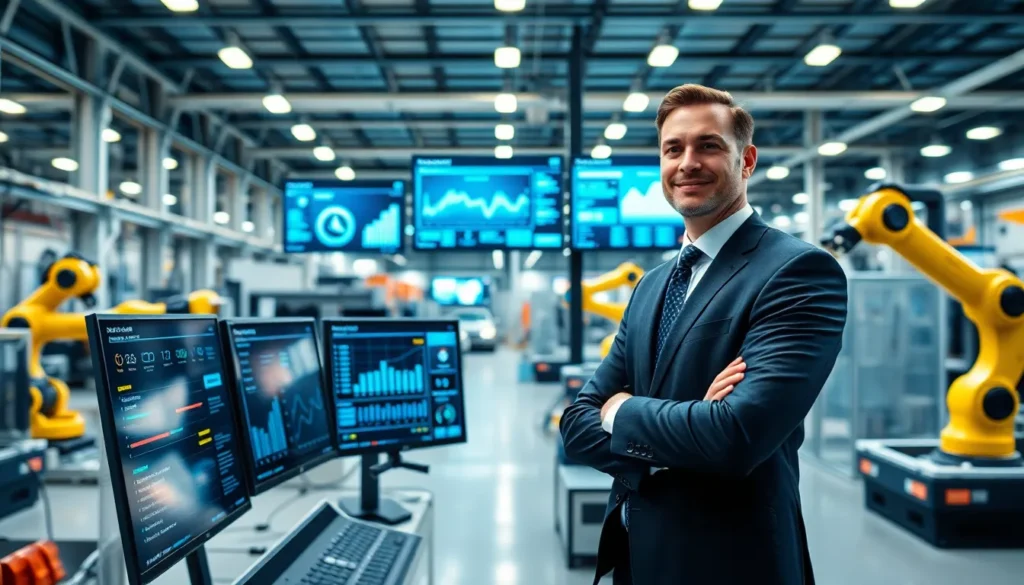Imagine waking up each day and knowing that many of your mundane tasks have been taken care of by machines. Sounds like a scene from a sci-fi movie? Well, welcome to the world of automation control. This cutting-edge technology is not just about robots doing the heavy lifting. It’s about optimizing processes, improving efficiency, and ensuring accuracy like never before. In this text, we’ll investigate deep into the nitty-gritty of automation control, bust some myths, and talk about why it’s the backbone of modern industries. So, buckle up and let’s jump into this intriguing realm.
Table of Contents
ToggleWhat Is Automation Control?

Automation control refers to the technology and processes that manage and regulate automated systems. Imagine a conductor leading an orchestra: automation control directs a range of systems to work harmoniously together without constant human intervention. This technology can be found in various forms, from simple tasks like controlling the temperature in a smart home to complex operations in manufacturing plants.
Essentially, it amalgamates different components like sensors, controllers, and software to streamline processes, eventually improving operational efficiency. At its core, automation control transforms tasks that typically require human cognition into streamlined automated actions, allowing organizations to save time and resources.
The Importance of Automation Control in Modern Industries
The significance of automation control cannot be overstated: it’s akin to the digital heartbeat of modern industries. By automating repetitive tasks, businesses can focus on strategies that enhance innovation and customer engagement. Think about it: when machines take care of the dull stuff, human workers can channel their energies into creativity and problem-solving.
Also, automation control leads to remarkable cost savings. Businesses can reduce labor costs, minimize human errors, and enhance safety in high-risk environments. The end result? A leaner operation with higher productivity. In sectors such as manufacturing, healthcare, and logistics, automation control isn’t just beneficial: it’s essential for maintaining competitive advantage.
Types of Automation Control Systems
Diving deeper, we can categorize automation control systems into a few types that collectively contribute to various industries. These types can range from manufacturing and assembly to process and control systems. Each type plays a pivotal role in enhancing operational workflows.
Key Components of Automation Control Systems
Every automation control system comprises essential components that work together efficiently. These include controllers, sensors, actuators, and software programs that communicate data back and forth. Each component performs specialized functions, ensuring everything operates seamlessly.
Sensors and Actuators
Sensors are the eyes of the automation control system. They collect real-time data like temperature, pressure, and speed. Actuators, on the other hand, act upon the commands from controllers to perform physical actions, such as opening a valve or moving a conveyor belt. Together, they form the backbone of the automation control landscape.
Controllers and Software
Controllers are like brains, they process the information gathered by the sensors and send commands to the actuators. Software plays a pivotal role here, not only in processing data but also in providing human-machine interfaces that help operations.
Human-Machine Interfaces
Human-Machine Interfaces (HMIs) allow operators to interact with the automation control system easily. They provide graphical data visualization, making it simpler to monitor system performance and troubleshoot issues, so bridging the gap between humans and machines.
Applications of Automation Control
The applications of automation control are vast and varied, spanning numerous industries. In manufacturing, automated assembly lines increase productivity and reduce waste. In agriculture, automated irrigation systems optimize water use and crop yields.
But the brilliance of automation control doesn’t stop there. In healthcare, robotic surgery systems are revolutionizing patient care by enhancing precision in complex operations. In the energy sector, smart grids use automation control for efficient energy distribution, adapting to real-time power demand. As technology evolves, so do the applications, creating an alluring landscape for future innovations.
Challenges and Considerations in Automation Control
Along with the benefits of automation control come its challenges. Transitioning to an automated system can be an uphill battle for some organizations. Ensuring employee buy-in is crucial: resistance to change is often rooted in fear, fear of job loss or a lack of understanding.
Security also poses a significant concern. Cybersecurity threats are real, and as systems become more connected, the vulnerabilities increase. Implementing robust security measures and regular updates is necessary to mitigate risks. Also, maintaining the interoperability of mixed systems, where old and new technologies coexist, requires expertise and thoughtful planning. Leaders need to address these challenges head-on to harness the true potential of automation control.
Future Trends in Automation Control
Looking ahead, automation control is on the precipice of significant advancements. Emerging technologies like artificial intelligence (AI) and machine learning are set to redefine automation paradigms. By enabling machines to learn from data and improve operational techniques autonomously, businesses can anticipate needs and make real-time adjustments.
Also, the growing trend of the Internet of Things (IoT) means that more devices will be interconnected. This will lead to larger networks of automated systems that can talk to each other, creating smarter and more efficient environments. Eventually, the future of automation control promises not just improved efficiency but also a synergy between human creativity and machine precision.






